Trip to Greece
The story of King Porus, and the valour he exhibits during his many battles with Alexander the Great and his Macedonian army is a popular story narrated to all kids who grow up in India. Although there is disagreement among world historians to this day regarding the historical accuracy of these battles, including the result, what is at least well known is that, after the battles, the two developed a lasting friendship that lasted their life times. Although Alexander’s began his campaigns in Asia mostly motivated by revenge, and for accumulation of wealth, he inadvertently also created a “cultural highway” between the west and east, and this helped spread many ideas on art, literature, science, mathematics and religion in both directions.
After Alexander’s death, and during the hellenistic period that followed, many Greek (and Indo-Greek) kings still continued to rule near the border of modern day India as well as from Bactria (present day Pakistan). Young aspiring artists, gymnasts and scholars left Macedon and Greece to live in Asia as far as India. Some Greek historians such as Megasthenes and others lived in the courts of Indian rulers including those of Chandragupta Maurya (known to ancient Greeks as “Sandrocottus”) as well as his grandson, Emperor Ashoka.
Like the generations of leaves, the lives of mortal men. Now the wind scatters the old leaves across the earth, now the living timber bursts with the new buds and spring comes round again. And so with men: as one generation comes to life, another dies away. ~ Homer, The Iliad
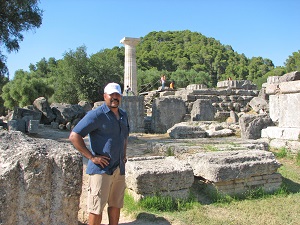
Fascinated by these interconnections between Indian and Greek history, as well as by many other aspects of the Greek culture including their influences in the areas of philosophy, mathematics and science, my wife and I took a history trip to Greece recently. And much like our previous history tour of the Mediterranean (which included a tour of Turkey), we took a packaged tour again and travelled with many other ardent history lovers from the Canada, United States, Argentina and Australia. The 9-day historical tour of the Greek mainland called “Best of Greece 2006” was worth every penny. After the tour, we also spent an extra week in the islands, including Crete and Santorini. We then flew back to Athens where after a few days, we left for Canada.

Athens and Corinth
The tour started in Athens where after a briefing by the tour director on some basic information about the tour as well as some rules to follow during the tour, we left to visit many famous sights in the city of Athens including the Parthenon, the Temple of Zeus and Hadrian’s Arch.
The city of Athens has existed in one form or the other for the past 7000 years, and is named after the Greek goddess, Athena, who is the matron/protector of the city according to ancient legends. The Parthenon is a temple dedicated to this goddess and is located on the southern part of the Acropolis summit. It was built after the Battle of Marathon when the Greeks successfully defeated the army of the great Persian king, Darius I. The complex itself was the significantly expanded during the time of Pericles who was a patron of arts and literature, and who reigned during the time of Greek history which is often referred to as the “classical period”.
The temple was in a state of renovation, and we were told that the renovations were originally targeted for completion by the 2004 Summer Olympics but had still not been completed. After the tour of the temple complex which included other smaller temples dedicated to other gods and goddesses, we made our way to a small museum which had many artifacts recovered from the temple complex. From there, we made out way to the Royal Palace. There, we witnessed a change of the guard ceremony performed by “Evzones”. One of the customs in Greece is that every male devotes at least two years to military service. From this pool of people, a special group are selected known as “Evzones”. According to our tour director, the rules of selection included being at least six feet tall as well as the ability to remain motionless for very long periods of time.
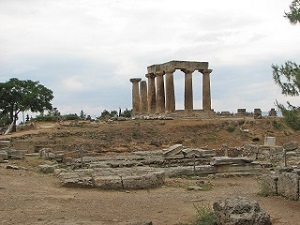
After watching the change of guard, we made our way to the Temple of Zeus. This colossal temple was built during the 6th century BC and was renovated until the 2nd century AD during the Roman occupation of Greece. It is in utter ruins now as it was repeatedly pillaged from the 3rd century on until recent times for building materials. There was once a massive statue of Zeus at the western end of this temple which stood nearly 40 feet tall. Unfortunately, nothing remains of this statue anymore.
From here, we made our way to the Arch of Hadrian. The Roman emperor Hadrian was a patron of Greece and funded many monumental projects in Greece during his reign including the renovation of the Temple of Zeus. According to our tour guide, this structure was built to honour him during his visit to Athens. Later, we also drove to the stadium which hosted the first modern Olympic games in 1896 and spent a short time taking pictures there.
From Athens, we left for Nauplia which used to be the capital of Greece near the end of the 19th century. On the way, we stopped to do some sight seeing at the ancient city of Corinth. We saw the Corinthian canal which was constructed near the last part of the 19th century as we pulled into the city. Corinth is located on a narrow stretch of land that joins the Peloponnese to the mainland of Greece. Our tour guide narrated its rich history including its religious significance. The Corinthians were once a mighty naval power and were able to establish colonies as far as Syracuse and flourished until they were conquered by Alexander the Great’s father, Philip II of Macedon.
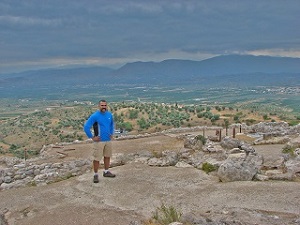
The city was very similar in layout of another ancient city, Ephesus, which we had visited in the west coast of Turkey in 2005, and had fountains, paved streets, many baths and a market place. The tour guide explained that most of the ruins that were visible were Roman in origin as this city was destroyed and later renovated by many Roman emperors including Julius Caesar. One of most notable ruins here is the temple dedicated to the god Apollo of which only very few Doric columns remain. There was also a small museum which had very interesting artifacts collected from this site.
Mycenae, Epidaurus and Nauplia
We then drove to Mycenae, a place I had wanted to visit since my childhood. This site was first excavated by Heinrich Schliemann, the famous German archaeologist, in 1874 who also excavated the site of Troy. We visited the famous palace of Agamemnon which is surrounded by some great walls. At the entrance to this palace is the famous Lions Gate which features engravings of two ferocious lionesses. What was so remarkable was that the walls of the fortress were constructed by mostly unworked boulders which were up to 30 feet thick in some places. Inside, these walls nothing much remains except a dug out probably for storing water during times of sieges. The residences were arranged so that the lower classes lived on the lower levels, and the upper classes lived in residences that were situated in much higher and more well-developed grounds.
Very close to this site, on a hill nearby was a beehive tomb called the “Treasury of Atreus” that we also managed to visit. This one of several other tombs here, and many members of the Mycenaean royal family were buried here. Schliemann uncovered many impressive treasures from these tombs. One of the most famous artifacts discovered within one of these tombs is the “Mask of Agamemnon”. It was discovered by Heinrich Schliemann who gave it its mythical name. These tombs are called “Tholoi” in Greek, and according to our tour guide are also found among several other cultures in the Mediterranean and West Asia.
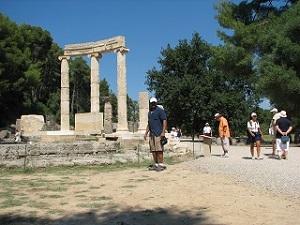
From Mycenae, we drove to the Sanctuary of Asclepius at Epidaurus. Asclepius was the God of Medicine to the ancient Greeks. He was one of the sons of the God Apollo, and according to legends, he was given the healing gift after his mother died at his birth. This place came to be famous starting the 4th century BC and was famous for both its temples and hospitals. Once every four years, a famous festival took place here, and many dramas were staged here during this festival. There is a very well-preserved amphitheatre here, and it seats nearly 14.000 people. This whole place is located within a dark green pine forest, and the whole experience was very mystical due to its calm and cool environment even in August when it is very hot elsewhere.
There was also a small museum at Epidaurus, but we did not have time to visit it and we headed towards Nauplia (or “Nafplion” as it is sometimes also called). Nafplion is a small sea port town in the Peloponnese region of Greece and has sometimes been called the “Naples of Greece”. This beautiful town has been coveted and conquered by many civilizations including the Ottomans and the Venetians. There are many forts here, and the two main forts here that are worth seeing are the Palamidi and the Bourtzi. The Palamidi was built by the Venetians, and towers over the entire town high up on a hill. You can either take the steps there (nearly a thousand), or you can drive up all the way up. The Bourtzi is a small fortification built on a small rock island and is only 5 minutes from the port. After taking some of these sights, we retired early that night to rest up for another full day ahead.
Olympia, Delphi and Kalambaka
From Nauplia we made our way to Olympia where the ancient Olympics were held every four years starting from about 776 BC until 426 AD when it is banned by the Roman emperor Theodosius II. This must be one of the most serene places that we have visited anywhere. There were tall trees offering a great shade from the Sun, the chirpy crickets, and the beautiful floral landscape making it one of the best archaeological places I have ever visited. Due to several earthquakes over the many millennia, nothing much remains except foundations and columns of what must have been very impressive temples once upon a time. The highlights for me here were the ruins of the Temple of Zeus, the Temple of Hera, the Philippeion, the Olympic Stadium where many athletic events were held, and the great museum nearby housing many artifacts collected from this site. According to our tour guide, the temple of Zeus had once housed a 12-metre high statue made of ivory and gold. If this is true, this must have been quite a sight for the athletes and other visitors who came to this venue.
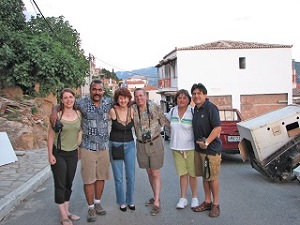
From Olympia, we made our way to the great site of Delphi. I hadn’t read anything in detail about this place, and so, I had no idea what to expect. This place sits on what I consider the most spectacular location in all of mainland Greece. The drive by the sea is visually breath taking, and if I were to go again to Greece, I would probably spend a lot more time here. This entire temple complex sits on mighty Mount Parnassos which is known to emit hallucinogenic gases from its many caves and crevices and is considered by many scientists to be reason for the mystical experiences for the oracles, the priests as well as for the many visitors from all over the Greek world.
The highlights of this place besides the visually stunning landscapes were the Temple of Apollo (or the Temple of Delphi), the many “treasuries” or offering sites which were erected to commemorate many significant events including the victory at Marathon by the Athenians, the theatre which was used to stage plays of religious significance, and the stadium located on top of the mountain which seats nearly 7000 spectators. There is also a fabulous museum here and houses many artifacts including jewellery and statues (including the famous “Charioteer”) excavated from this site over the last few hundred years. If you find yourself in Greece, Delphi and Olympia are two places you must visit as they simply take your breath away.

From Delphi, we made our way to Kalambaka to see the Meteora monasteries that are perched high upon the summits of rocks. Monastic tradition has existed here at least since the 11th century AD. However, the many monasteries here were built in the 14th century A.D of after. We visited a couple of monasteries here including the Holy Monastery of Great Meteoron and got a glimpse of the Greek Orthodox tradition. Our tour guide did an excellent job of narrating the origins of the Greek Orthodox religion and how it has influenced Greek life and culture over the centuries. The town of Kalambaka itself is a nice little place with numerous shops selling souvenirs. We had an amazing lunch here at a restaurant run by an old Greek lady.
Thermopylae and Back to Athens
Next, we left for Athens again. However, we stopped at Thermopylae. This site is where the Battle of Thermopylae was fought according to many historians. There is very little for a tourist to see here except the monument to King Leonidas I. This monument sits on the highway leading to Athens which connects upper and lower Greece. We spent about an hour here and left for Athens. We had a plane to catch to fly to Crete the next day and were anxious to catch up on some rest and relaxation. We had a great farewell supper with our tour group at Plaka. Plaka is a wonderful place to visit and is located right close to the Acropolis, and at nights, you can sit outside and have a great meal under the shadows of the Parthenon that towers above you.

Crete and Santorini
Next day, we flew to the island of Crete which is one of the most famous destinations in Greece. We stayed a few miles outside the city of Heraklion in a resort. After a day of rest here, we took a day long tour which included the tour of the Palace of Knossos which provides many insights into the Minoan civilization and how the Minoans lived. This first large-scale excavation of this site was done by Sir Arthur Evans. This palace and many others on the island were destroyed roughly around 1700 BC and were renovated only to be destroyed again a few hundred years later. The ruins gave a glimpse into what I think must have been a really peaceful civilization. We then continued towards the Dikti Mountain and the plateau of Lassithi. On the way, we stopped at a small village called “Tzermiado” for lunch. Here, we had the most delicious meal we probably had in all of Greece. There were nice little souvenir shops here selling Minoan imitations of vases and statues.
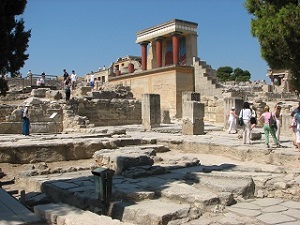
We made a visit to a traditional pot making factory here, and later drove to the site of the Diktaion cave which is rumoured to be the birth place of the Greek god, Zeus in mythology. The walk up to the hill was not easy in the heat (we were there in early August, and temperatures soared up to 40 degrees some days). We descended into the cave and saw some incredible icy stalagmite and stalactite formations. We returned to our resort late in the evening.
Near the later part of the week, we left for Santorini on a day trip. Our cruise ship offered many viewing decks to sit and relax as we travelled the Aegean, and we arrived in the port of Athinios a few hours later. From here, we took a bus and made our way to Oia (pronounced “E-ah”) which faces south towards Egypt. This is a must-see place and features the famous white and blue churches that contrast amazingly well against the blue Aegean Sea. It was packed with hundreds of tourists making their way through the narrow white washed streets. There were numerous shops including some very expensive jewellery boutiques here.
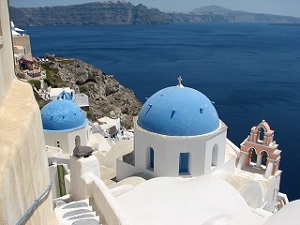
The central square offers tourists plenty of opportunities to take post card-type pictures and after some shopping and a great lunch, we made our way back to boat. We saw the famous Santorini sunset as we left, and it was truly amazing sight. I would really like to go back here and spend many days here the next time. The evening trip on the cruise ship featured dance and entertainment. This was a great way to end an action-packed day. We left for Athens again after a week, and after spending two days sight seeing including a trip to the National Archaeological Museum, we left for Canada.
Trip Summary
Although we did not visit Northern Greece and visit some other historically significant sites such as Pella for instance, this tour provided a deep insight into Greek history and tradition and I would highly recommend it to anyone looking to do their first tour of Greece. We do intend to go back in a few years if we can save up some money and visit many historical places including the many islands in the Ionian and the Aegean seas.